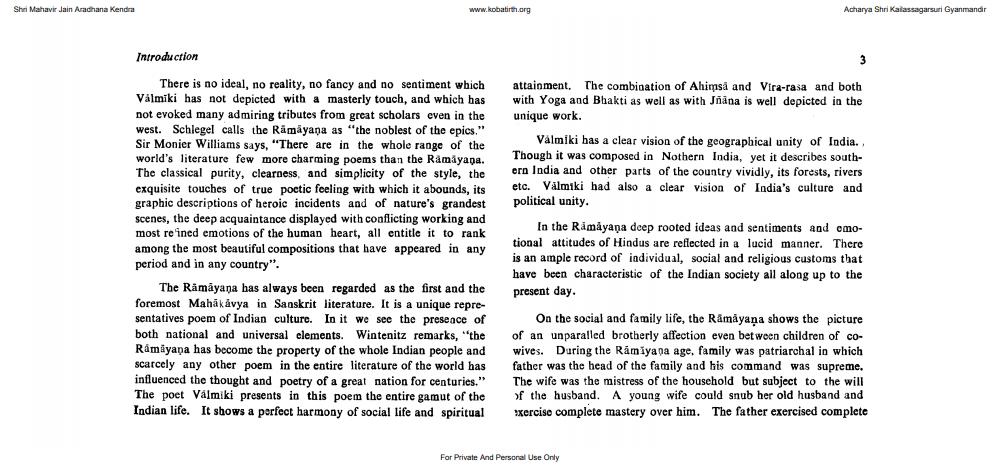Book Title: Valmiki Ramayanam Part 01 Author(s): Amar Publication Publisher: Amar Publication View full book textPage 9
________________ Shri Mahavir Jain Aradhana Kendra www.kobatirth.org Introduction There is no ideal, no reality, no fancy and no sentiment which Valmiki has not depicted with a masterly touch, and which has not evoked many admiring tributes from great scholars even in the west. Schlegel calls the Ramayana as "the noblest of the epics." Sir Monier Williams says, "There are in the whole range of the world's literature few more charming poems than the Ramayana. The classical purity, clearness, and simplicity of the style, the exquisite touches of true poetic feeling with which it abounds, its graphic descriptions of heroic incidents and of nature's grandest scenes, the deep acquaintance displayed with conflicting working and most refined emotions of the human heart, all entitle it to rank among the most beautiful compositions that have appeared in any period and in any country". The Ramayana has always been regarded as the first and the foremost Mahākávya in Sanskrit literature. It is a unique representatives poem of Indian culture. In it we see the presence of both national and universal elements. Wintenitz remarks, "the Ramayana has become the property of the whole Indian people and scarcely any other poem in the entire literature of the world has influenced the thought and poetry of a great nation for centuries." The poet Valmiki presents in this poem the entire gamut of the Indian life. It shows a perfect harmony of social life and spiritual Acharya Shri Kalassagarsuri Gyanmandir 3 attainment. The combination of Ahimsa and Vira-rasa and both with Yoga and Bhakti as well as with Jñana is well depicted in the unique work. Valmiki has a clear vision of the geographical unity of India.. Though it was composed in Nothern India, yet it describes southern India and other parts of the country vividly, its forests, rivers etc. Valmiki had also a clear vision of India's culture and political unity. In the Ramayana deep rooted ideas and sentiments and emotional attitudes of Hindus are reflected in a lucid manner. There is an ample record of individual, social and religious customs that have been characteristic of the Indian society all along up to the present day. For Private And Personal Use Only On the social and family life, the Rāmāyaṇa shows the picture of an unparalled brotherly affection even between children of cowives. During the Ramiyana age, family was patriarchal in which father was the head of the family and his command was supreme. The wife was the mistress of the household but subject to the will of the husband. A young wife could snub her old husband and xercise complete mastery over him. The father exercised completePage Navigation
1 ... 7 8 9 10 11 12 13 14 15 16 17 18 19 20 21 22 23 24 25 26 27 28 29 30 31 32 33 34 35 36 37 38 39 40 41 42 43 44 45 46 47 48 49 50 51 52 53 54 55 56 57 58 59 60 61 62 63 64 65 66 67 68 69 70 71 72 73 74 75 76 77 78 79 80 81 82 83 84 85 86 87 88 89 90 91 92 ... 468
